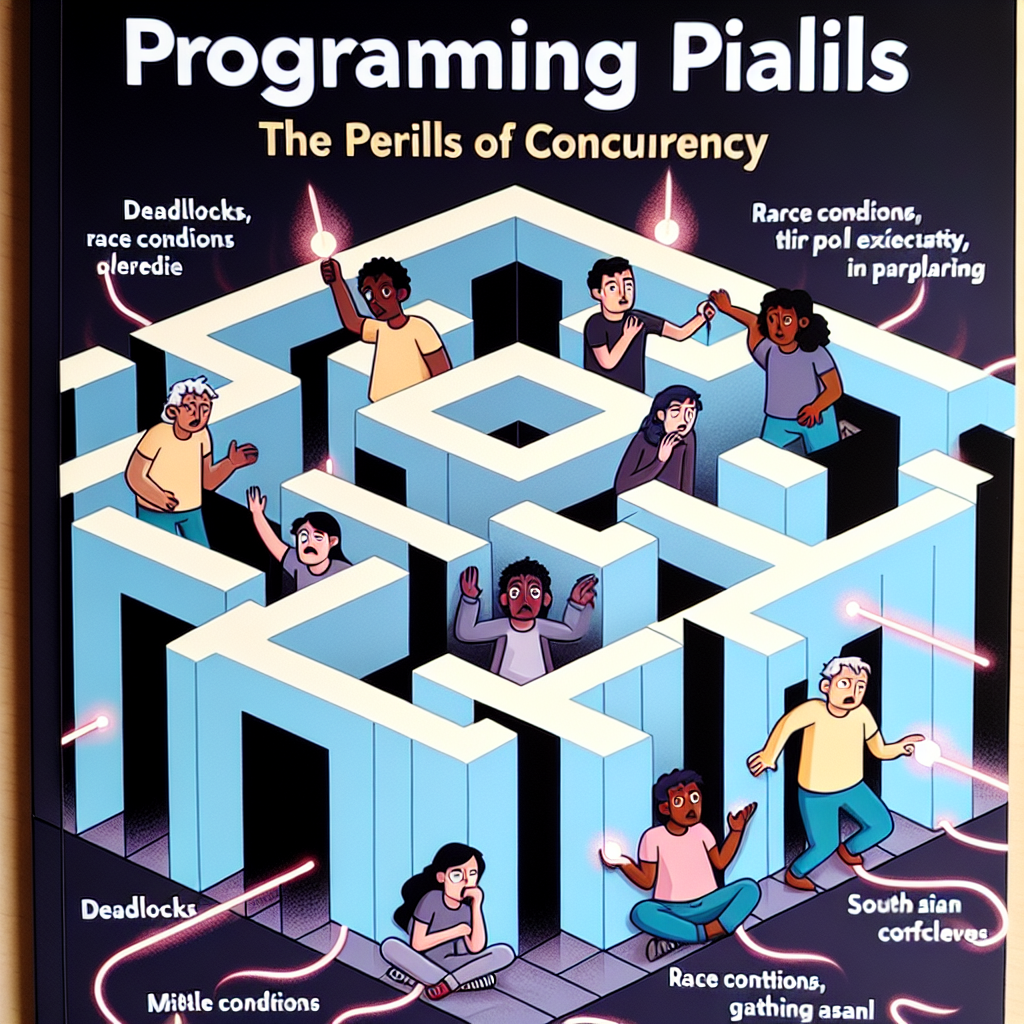Introduction
Parallel programming, a cornerstone of modern computing, promises significant performance gains by leveraging multiple processors to execute tasks concurrently. However, this approach is fraught with challenges that can undermine its potential benefits. The perils of concurrency manifest in various forms, such as race conditions, deadlocks, and resource contention, which can lead to unpredictable behavior, degraded performance, and complex debugging processes. Understanding these pitfalls is crucial for developers to effectively harness the power of parallelism while mitigating the risks associated with concurrent execution. This introduction delves into the common issues encountered in parallel programming and underscores the importance of robust design and testing practices to navigate the intricate landscape of concurrency.
Deadlocks: Understanding and Avoiding System Freeze
In the realm of parallel programming, one of the most formidable challenges developers face is the phenomenon known as deadlocks. Deadlocks occur when two or more processes become stuck in a perpetual waiting state, each holding a resource the other needs to proceed. This situation results in a system freeze, where no progress can be made, effectively halting the execution of the program. Understanding the intricacies of deadlocks and implementing strategies to avoid them is crucial for ensuring the reliability and efficiency of concurrent systems.
To comprehend the nature of deadlocks, it is essential to recognize the four necessary conditions that must be present for a deadlock to occur. These conditions are mutual exclusion, hold and wait, no preemption, and circular wait. Mutual exclusion refers to the requirement that at least one resource must be held in a non-shareable mode. Hold and wait describes a scenario where a process is holding at least one resource and waiting to acquire additional resources that are currently being held by other processes. No preemption implies that resources cannot be forcibly taken away from a process; they must be released voluntarily. Finally, circular wait is a condition where a set of processes are waiting for each other in a circular chain, creating a cycle of dependencies.
Given these conditions, it becomes apparent that preventing deadlocks involves breaking at least one of them. One common strategy is to employ resource allocation policies that avoid circular wait. This can be achieved by imposing a strict ordering on resource acquisition, ensuring that all processes request resources in a predefined sequence. By doing so, the circular chain of dependencies is disrupted, thereby preventing deadlocks.
Another effective approach is to use a resource allocation graph to detect potential deadlocks before they occur. In this method, nodes represent processes and resources, while directed edges indicate the allocation and request of resources. By analyzing the graph for cycles, it is possible to identify situations that could lead to deadlocks. If a cycle is detected, the system can take corrective actions, such as aborting one or more processes to break the cycle and release the held resources.
Additionally, implementing a timeout mechanism can help mitigate the impact of deadlocks. By setting a maximum wait time for resource acquisition, processes that exceed this limit can be terminated or rolled back, freeing up resources and allowing other processes to continue. This approach, while not preventing deadlocks entirely, ensures that the system does not remain in a frozen state indefinitely.
Furthermore, employing deadlock avoidance algorithms, such as the Banker’s algorithm, can provide a more proactive solution. The Banker’s algorithm evaluates resource allocation requests based on the current state of the system and the maximum potential future requests. If granting a request would lead to an unsafe state, where a deadlock could occur, the request is denied. This ensures that the system remains in a safe state, where all processes can eventually complete their execution without encountering deadlocks.
In conclusion, deadlocks pose a significant threat to the stability and performance of parallel programs. By understanding the conditions that lead to deadlocks and implementing strategies to prevent or mitigate them, developers can enhance the robustness of their concurrent systems. Whether through resource allocation policies, detection mechanisms, timeout strategies, or avoidance algorithms, addressing the perils of concurrency is essential for maintaining the smooth operation of parallel applications.
Race Conditions: Ensuring Data Integrity in Concurrent Systems

In the realm of parallel programming, one of the most critical challenges developers face is ensuring data integrity in concurrent systems. As multiple threads or processes execute simultaneously, they often need to access and modify shared data. This concurrent access can lead to race conditions, a perilous situation where the system’s behavior becomes unpredictable due to the timing of thread execution. Understanding and mitigating race conditions is essential for maintaining the reliability and correctness of concurrent applications.
Race conditions occur when two or more threads access shared data and try to change it at the same time. If the access is not properly synchronized, the final outcome depends on the sequence of thread execution, which can vary from one run to another. This non-deterministic behavior can lead to subtle and hard-to-diagnose bugs, making the system unreliable. For instance, consider a simple banking application where two threads simultaneously attempt to update the balance of a shared account. Without proper synchronization, the final balance may not reflect the correct sum of the transactions, leading to data corruption.
To prevent race conditions, developers must employ synchronization mechanisms that control the access to shared resources. One common approach is the use of locks, which ensure that only one thread can access the critical section of code at a time. By acquiring a lock before entering the critical section and releasing it afterward, developers can serialize access to shared data, thereby preventing concurrent modifications. However, while locks are effective, they can introduce other issues such as deadlocks, where two or more threads are waiting indefinitely for each other to release locks.
Another technique to avoid race conditions is the use of atomic operations. These operations are indivisible, meaning they complete without any possibility of interruption. Modern processors and programming languages provide atomic instructions that can be used to perform simple operations like incrementing a counter or updating a pointer safely. By leveraging atomic operations, developers can ensure that critical updates to shared data are performed without interference from other threads.
In addition to locks and atomic operations, higher-level synchronization constructs such as semaphores, barriers, and condition variables can be employed. Semaphores are signaling mechanisms that control access to a shared resource by maintaining a count of available permits. Barriers synchronize threads at a specific point, ensuring that all threads reach the barrier before any can proceed. Condition variables allow threads to wait for certain conditions to be met before continuing execution. These constructs provide more flexibility and can be used to design complex synchronization schemes tailored to specific application requirements.
Despite the availability of these synchronization mechanisms, achieving correct and efficient synchronization remains a challenging task. Overuse of locks can lead to contention, where threads spend significant time waiting for locks to be released, thereby degrading performance. Conversely, insufficient synchronization can result in race conditions and data corruption. Therefore, developers must strike a delicate balance between ensuring data integrity and maintaining system performance.
In conclusion, race conditions pose a significant threat to data integrity in concurrent systems. By understanding the nature of race conditions and employing appropriate synchronization mechanisms, developers can mitigate these risks and build reliable parallel applications. However, the complexity of concurrent programming demands careful design and thorough testing to ensure that synchronization is both correct and efficient. As parallel computing continues to evolve, mastering these techniques will remain a crucial skill for developers aiming to harness the full potential of modern multi-core processors.
Thread Contention: Managing Resource Access in Parallel Programs
In the realm of parallel programming, one of the most significant challenges developers face is managing resource access among multiple threads. This issue, known as thread contention, arises when multiple threads attempt to access shared resources simultaneously, leading to potential conflicts and performance bottlenecks. Understanding and mitigating thread contention is crucial for ensuring the efficiency and reliability of parallel programs.
Thread contention occurs when threads compete for the same resource, such as memory, data structures, or I/O devices. When a thread gains access to a resource, other threads must wait until the resource becomes available again. This waiting period can significantly degrade the performance of a parallel program, as it negates the benefits of concurrent execution. Consequently, developers must employ strategies to manage resource access effectively and minimize contention.
One common approach to managing thread contention is the use of synchronization mechanisms, such as locks, semaphores, and monitors. These tools help coordinate access to shared resources by allowing only one thread to access a resource at a time. While synchronization mechanisms can prevent data corruption and ensure consistency, they can also introduce overhead and reduce parallelism. For instance, if a lock is held for an extended period, other threads may be forced to wait, leading to increased contention and decreased performance.
To mitigate the impact of synchronization overhead, developers can adopt fine-grained locking techniques. Instead of using a single lock for an entire data structure, fine-grained locking involves using multiple locks for different parts of the structure. This approach allows multiple threads to access different parts of the resource concurrently, reducing contention and improving performance. However, fine-grained locking can be complex to implement and may introduce additional challenges, such as deadlocks and increased code complexity.
Another strategy to manage thread contention is lock-free programming. Lock-free algorithms are designed to allow multiple threads to access shared resources without the need for explicit locks. These algorithms rely on atomic operations, such as compare-and-swap, to ensure consistency and prevent conflicts. While lock-free programming can offer significant performance benefits, it requires a deep understanding of concurrent programming principles and can be challenging to implement correctly.
In addition to synchronization mechanisms and lock-free programming, developers can also reduce thread contention by minimizing the use of shared resources. One way to achieve this is through data partitioning, where data is divided into smaller, independent chunks that can be processed concurrently by different threads. By reducing the need for threads to access shared resources, data partitioning can significantly decrease contention and improve parallel program performance.
Moreover, developers can employ techniques such as thread-local storage, where each thread maintains its own copy of a resource. This approach eliminates the need for synchronization and reduces contention, as threads do not need to compete for access to shared resources. However, thread-local storage may increase memory usage and may not be suitable for all types of applications.
In conclusion, managing resource access in parallel programs is a critical aspect of ensuring efficient and reliable concurrent execution. Thread contention can significantly impact performance, and developers must employ various strategies to mitigate its effects. Synchronization mechanisms, fine-grained locking, lock-free programming, data partitioning, and thread-local storage are all valuable tools in the developer’s arsenal. By carefully considering the trade-offs and complexities associated with each approach, developers can effectively manage thread contention and harness the full potential of parallel programming.
Q&A
1. **What is a common issue in parallel programming related to shared resources?**
– **Answer:** Race conditions, where multiple threads or processes access and modify shared data concurrently, leading to unpredictable results.
2. **What is deadlock in the context of parallel programming?**
– **Answer:** Deadlock occurs when two or more threads or processes are unable to proceed because each is waiting for the other to release a resource, causing a standstill.
3. **How can improper synchronization affect parallel programs?**
– **Answer:** Improper synchronization can lead to issues such as data corruption, inconsistent states, and unexpected behavior due to threads not coordinating correctly when accessing shared resources.Parallel programming, while offering significant performance benefits, is fraught with challenges such as race conditions, deadlocks, and non-deterministic behavior. These pitfalls arise from the inherent complexity of managing concurrent tasks and shared resources. Effective parallel programming requires careful design, thorough testing, and often sophisticated synchronization mechanisms to ensure correctness and efficiency. Understanding and mitigating these perils is crucial for leveraging the full potential of parallel computing.

